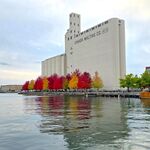None of this is absolutely decided yet, although the idea is since Bombardier won the contract, they now likely have first dibs at any Transit City contracts. Expect a train which looks basically exactly like the ones just ordered, except don't need to be customized for the legacy system's tight turns and steep grades.
Brandon, you should also watch this video on the TTC website:
http://www3.ttc.ca/About_the_TTC/Projects_and_initiatives/Transit_city/index.jsp
I watched that video last year, but thank you for the information.
Actually, I'm surprised few people have caught on to how different the Flexity Light Rail and Flexity Tram models are when I posted links to the official web site. The dimensions of the Flexity Tram are actually smaller for the car itself, and they aren't as modular: I think they can be customized to handle two cars per train at the most (again, with smaller physical size which also makes capacity slightly less). The Flexity Light Rail vehicles are what Eglinton needs, it would be a mistake to use anything less.
(and this is not a flame war on light rail vs tram, bombardier obviously makes two versions and they market one as a tram and the other as a light rail vehicle)
The Star reported that the TC order will be completely separate from the TTC Streetcar replacement order, on the link provided earlier in this discussion.
So if the order is going to be completely separate, and if Bombardier has two different styles of Flexity vehicles, I am inclined to think that Eglinton LRT will be using the larger version of the car. But again, it seems the TC people haven't announced anything to let us really know.
My belief is this: if they create a simple street-car like line on Eglinton, albeit with the tunnel, and they use a tram that doesn't have more than 2 conjoined cars per train the line is going to need more capacity as soon as it opens.
But its pure speculation on my part: I don't know if that's what they intend on doing. I keep hearing different information from different sources: some people who claim to have "insider" knowledge say its going to be 3 light rail cars per train, others say its using the same new streetcar/tram type cars that is going on the regular streetcar system (a major flaw if this is true, imo), and some people claim it'll be light rail, but not 3 cars, only 2 cars per train (and the TC video on the official site actually has a diagram built only for 2 cars per train).
Who really knows? LOL
Part of the problem with TC is that there isn't enough clarification coming out of the marketing division. They need to have more accurate diagrams and construction plans published on the TTC we site.










